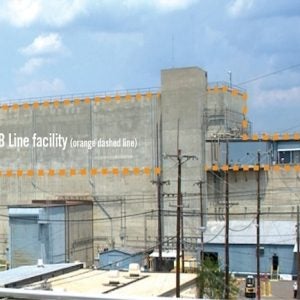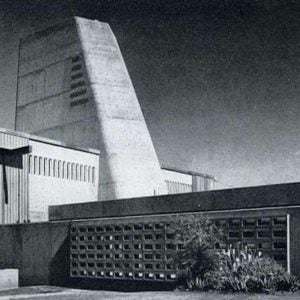Germany is clearly one of the leading nations in nuclear power, with a long record of both successful research and development work and also active development of nuclear in operating reactors. Nevertheless, a phaseout of nuclear power is now enshrined in law, with strict limitations imposed on the operating lives of the reactors such that the last will close in the early 2020s. As such, this is much more serious as a phaseout plan than, for example, in Sweden, where the commitment is more long term and vague (yet has resulted in the two Barsebäck reactors closing). How has the threat to nuclear in Germany come about and what is likely to happen?
Germany’s 17 operating nuclear power reactors, comprising 20GWe of installed capacity, supply almost one third of the electricity. Many of the units are large and the last came into commercial operation in 1989. The operating performance has always been excellent, with many of the reactors achieving capacity factors above 90%. All the reactors were built by Siemens-KWU – six BWRs and 11 PWRs. Thirteen of the reactors are licensed to use mixed oxide (MOX) fuel, using plutonium recycled from spent fuel, under reprocessing contracts with Areva in France and BNFL in the UK. When Germany was reunited in 1990, all the Soviet-designed reactors in the east were shut down for safety reasons and are being decommissioned. These comprised four operating VVER-440s, a fifth one under construction, and a small older VVER reactor.
The other important elements to note in Germany’s electricity supply are coal and wind power. Coal provides just over half of the country’s electricity but some €2.5 billion per year is spent subsidising local coal mines. Yet arising from the Kyoto accord, Germany is committed to a 21% reduction of greenhouse gas emissions by 2010. Much of this has been achieved by shutting down energy inefficient old industries in the former East Germany, but there has been a major push towards wind power, backed by generous subsidies. Germany now has about half of Europe’s installed wind generating capacity, amounting to about 25% of its total capacity but still only 5% of electricity supply.
The roots of the nuclear phaseout law in Germany run very deep, as there has long been a strong anti-nuclear movement in the country. The practical impact of this has been substantial. The Mülheim-Kärlich PWR (the only Babcock and Wilcox PWR ever built outside the USA) was the subject of licensing disputes since the 1970s and was stripped of its licence by judges in 1988, shortly after it began trial operation. It never operated thereafter. Similarly, a MOX fabrication plant was built at Hanau, but was never allowed to operate, so all MOX fuel has been imported. Finally, the waste disposal sites at Ahaus, Konrad and Gorleben have been subject to significant political delays, with transport operations attracting significant anti-nuclear demonstrations, well-covered by the media.
In 1998 a coalition government was formed between the Social Democratic Party (SPD) and the Green Party, the latter having polled only 6.7% of the vote. As a result, these two parties agreed to change the law to establish the eventual phasing out of nuclear power. Long drawn-out ‘consensus talks’ with the electric utilities were intended to establish a timetable for phaseout, with the Greens threatening unilateral curtailment of licences without compensation if agreement was not reached. All operating nuclear plants have effectively unlimited licences, subject to safety compliance, with strong legal guarantees.
In 2000 a compromise was announced which, while limiting plant lifetime to some degree, averted the risk of any enforced plant closures during the term of that government. In particular, the agreement put a cap of 2.623TWh on lifetime production by all 19 then operating reactors, equivalent to an average lifetime of 32 years (less than the 35 years sought by industry). Two key elements were a government commitment to respect the rights of utilities to operate existing plants, and a guarantee that this operation and related waste disposal would be protected from any “politically-motivated interference.”
In June 2001 the leaders of the Red-Green coalition government and the four main energy companies signed an agreement to give effect to this compromise. The companies’ undertaking to limit the operational lives of the reactors to an average of 32 years meant that two of the smaller and least economic ones – Stade and Obrigheim – were shut down in 2003 and 2005 respectively, and that Mülheim-Kärlich would be decommissioned from 2003. It also prohibited the construction of new nuclear power plants for the time being and introduced the principle of onsite storage for used fuel.
|
“” |
|
More fossil powered generation capacity will be needed or electricity will have to be imported, conceivably from nuclear generation in France |
The agreement was effectively a pragmatic compromise from both sides, which provided a basis and time for formulation of a sound national energy policy during a period when environmental and security of supply issues are becoming paramount. From the standpoint of the nuclear sector, the key benefit it gave was time – to continue operating the reactors in the hope that the 2002 revision to the Atomic Energy Act could be overturned by political change. Opposition leaders in the CDU/CSU parties promised to reverse the decision as soon as they could but were thwarted in the 2005 elections. They did not achieve enough votes to avoid a coalition government and have now formed one with the still anti-nuclear SPD. Although the Chancellor, Angela Merkel, and other government leaders support the industry’s desire for an extension of plant operations to 40 years, at the very least, the nature of coalition politics has made this impossible. So German law is still for a phaseout as soon as the reactor generation allowances are used up.
The practical impact of this is now becoming serious, as four larger and highly economic reactors – Biblis A and B, Brunsbüttel and Neckarwestheim 1, are expected to use up their remaining generation allowances in 2008 or 2009, ahead of the next anticipated federal elections in autumn 2009. The utilities concerned are now using a variety of tactics to prevent such early closures, which are leading to legal actions between them and the government. One relates to the transfer of generation allowances from Mülheim-Kärlich to other reactors and another to reallocating allowances of reactors not scheduled to close until closer to 2020, to those under threat much sooner. Another possible tactic is to extend outages of these reactors so their allowances are not used up until after the next elections, in the hope that they will be saved by political change. Finally, if the worst comes to the worst and reactors are shut down, this apparently does not invalidate the operating licences, which remain effectively open-ended and only subject to regulators confirming that they meet safety standards. This opens the possibility of mothballing the reactors for subsequent restart should the political climate change, rather than decommission them (which in itself requires the issuing of a decommissioning licence by the regulator).
Nevertheless, these tactics avoid the central issue that the phaseout is enshrined in national law and the German political system seems to lead itself to coalitions with insufficient power to change things. Reallocating generation allowances is rather like rearranging the deckchairs on the Titanic and a satisfactory solution will only be found for the long term if nuclear achieves incorporation in long run German energy plans with popular support. This is going to be a significant battle – recent opinion survey results suggest that half the German population remains fundamentally critical of nuclear power and that, even in the overtly pro-nuclear CDU/CSU party, about one third of its supporters are against nuclear.
Probably the main hope is the anticipation that once the Germans are fully aware of the realities of a nuclear phaseout, they will react strongly against it. Renewable sources cannot possibly replace the power lost by closing the large nuclear plants, so more fossil powered generation capacity will be needed or electricity will have to be imported, conceivably from nuclear generation in France. Indeed, a January 2007 report by Deutsche Bank warned that Germany will miss its carbon dioxide emission targets by a wide margin, face higher electricity prices, suffer more blackouts and dramatically increase its dependence on gas imports from Russia as a result of its nuclear phaseout policy, if it is followed through. The Bank estimated that 42GWe of new generating capacity will need to be constructed by 2022 if the shutdowns proceed.
These realities seem rather obvious, but have not yet been appreciated by enough German voters. As elsewhere around the world, there has been a general complacency about energy for many years, which is only now being replaced by detailed national policy debates. Where nuclear power is well-established, such as in the USA and the UK, nuclear will play a important part in the debate, now not just relating to the continued operation of existing reactors but on new build too. Germany is a central element in the European Union too, where there is an important debate on energy concerning economics, environment and security of supply.
The impact on nuclear power as a whole if a German nuclear phaseout goes ahead would undoubtedly be very significant. With a clear leader in nuclear technology rejecting it, the chances of any new countries embracing the nuclear option look much slimmer. A country universally respected for its achievements in high technology engineering, shutting down large and highly economic generating units, is not the best advertisement for countries such as Indonesia and Vietnam, currently considering embarking on nuclear plans. It also seems highly unlikely that there would be substantial nuclear new build in the USA or elsewhere in Europe if Germany is phasing out reactors not substantially different from the new ones envisaged. Nuclear policy may still be nationally based but what is happening in other major countries is clearly still of some significance. The battle for continued operation of the German reactors is therefore a very important one.
More fossil powered generation capacity will be needed or electricity will have to be imported, conceivably from nuclear generation in France Quote 1 Steve Kidd is head of Strategy & Research at the World Nuclear Association Steve Kidd Author Info:
Steve Kidd is Head of Strategy and Research at the World Nuclear Association, where he has worked since 1995 (when it was the Uranium Institute). Any views expressed are not necessarily those of the World Nuclear Association and/or its members






